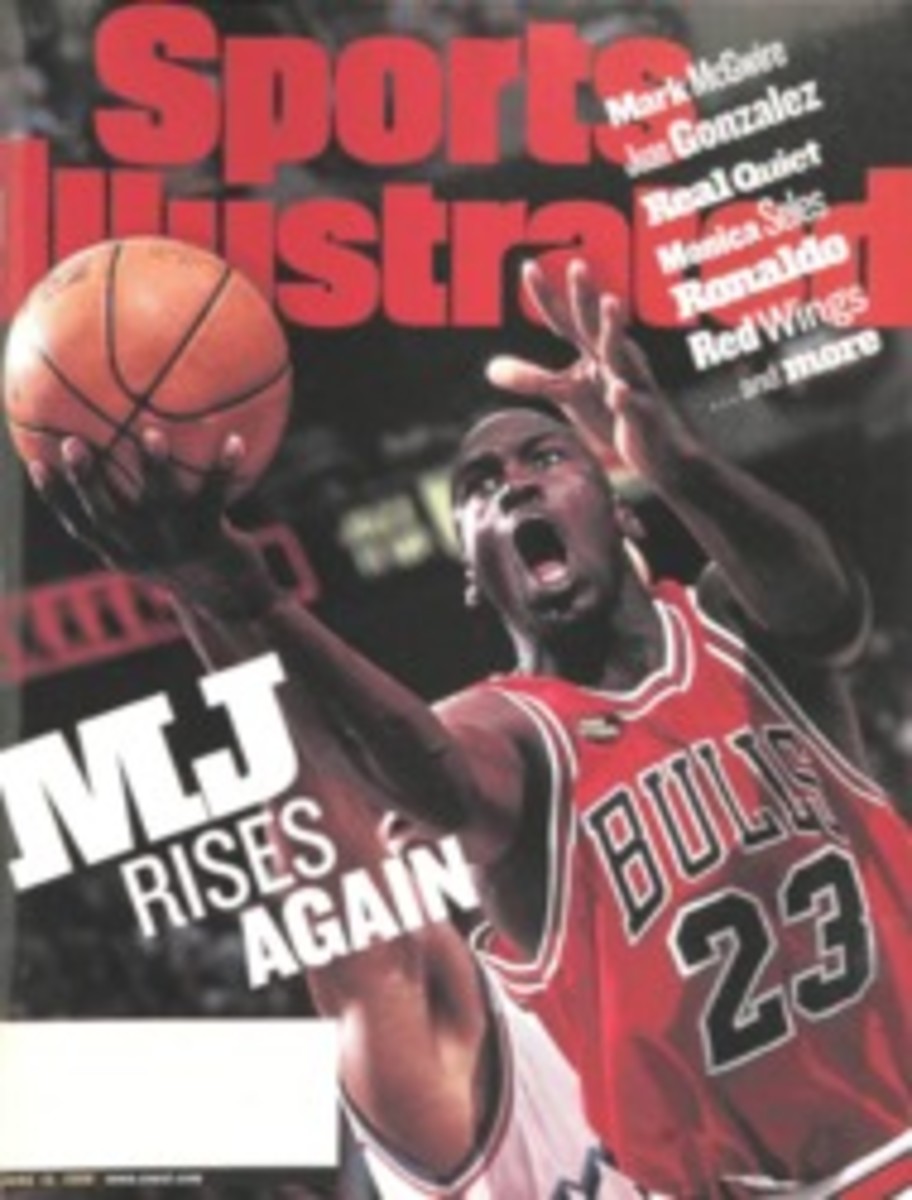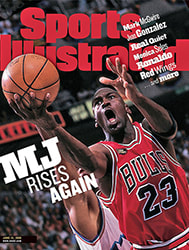
Impossible Dream Bud Chapman sees himself in the Open. His Infamous Holes are for others
And now, if you'll step over to the north wall--watch that
velvet rope, young fellow, it's not a swing set--we have
Chapman's "Portrait of the Artist as a Nonqualifier." The medium
is tempera glaze thinned with human tears. The artist painted it
in 1998, when he was 75. I call your attention to the brushwork.
The sure-handedness of Chapman's technique baffles art
historians because the artist by this time had the yips and was
experimenting with a long putter.
--MUSEUM GUIDE IN THE YEAR 2018
On this day, May 11, 1998, it isn't even a painting yet--just a
sketch small enough to fit in your wallet. The artist has put
himself in the foreground. He's seated on a golf bag, dejected,
his elbows on his knees, while in the background a woman posts
his score on a scoreboard marked U.S. OPEN QUALIFYING. Behind
him two golfers are exchanging a congratulatory handshake while
a third jumps for joy. The sketch is captioned, WELL, THERE'S
ALWAYS NEXT YEAR.
In his cluttered studio in suburban Minneapolis, Bud Chapman
studies the sketch. He has a weathered face full of laugh lines
and a chortle that mocks his quixotic nature. "There's always
next year," he murmurs. "Isn't that the truth?"
The Chapman story is by now a staple of Minnesota folklore,
niched somewhere between Lake Woebegone and Harold Stassen. For
more than half a century Loyal (Bud) Chapman has tried to
qualify for the U.S. Open. Every single time he has failed.
O.K., Charlie Brown struggles to fly a kite. But Chapman is one
of the nation's top commercial artists, famous for his Infamous
Golf Holes prints. Furthermore, he's an accomplished golfer who
has played in everything from the U.S. Amateur to the U.S.
Senior Open. Chapman has been named the Minnesota golfer of the
year in three decades. He shares the course record (64) at
Minneapolis Golf Club. He has played in competition with Arnold
Palmer, Lee Trevino and, he vaguely recalls, with Gene Sarazen.
Wielding a 55-inch driver, Chapman has even beaten Tiger Woods
in a long-drive contest. But in 47 attempts the artist has never
gotten through local and sectional qualifying and into an Open
field.
"It's a history of horror stories," Chapman says. One time he
failed in local qualifying because his caddie, searching for his
ball in greenside rough, inexplicably picked the ball up,
incurring a penalty. Another time Chapman blew his chance by
teeing off from the wrong tee box. More often, he has simply
scored poorly. As Chapman almost gleefully concedes, "I have a
tendency to choke."
He doesn't remember the first time he tried to
qualify--"Probably '44 or '45, it's all a blur," he says--but
can describe in wonderful detail his two ill-fated trips to the
sectionals. In 1984, at Chicago's Barrington Hill Country Club,
he needed pars on the last two holes to qualify. Instead, he
drove through a dogleg and into trees on the 17th and made a 6.
"That was close," he says, "but the worst one, the most
unbelievable situation, happened in Detroit. I was four or five
shots ahead of Sam Snead and Frank Stranahan in the last round
with two holes to play when I got to a par-4. I drove the darn
thing in the morning round, and I'm getting ready to hit when
the caddie says, 'Mr. Chapman, you've got it made. Just take an
iron.' I thanked him because it was the right thing to do. So I
pulled out a two-iron and hit it straight into the worst garbage
you could imagine."
Chapman grins. "I'm still O.K.," he says. "All I need is a
double or triple on the last hole to qualify because I had that
lead. It was a par-3, and jeez, I hit this six-iron, and I
thought it was going in the hole. It imbedded in the bank in
front of the green, but not too bad, and the pin was only about
10 feet away. The imbedded ball rule wasn't invented yet, so I
go up there and just tap the ball to get it out--and it goes in
a little deeper. So I tap it again, and it goes in deeper." He
laughs. "Now it's starting to get serious. I did that four or
five times, and finally I closed the blade like a sand shot and
exploded it out to about 40 feet. From there I four-putted and
missed qualifying by one."
Nitpickers with calculators may challenge Chapman's memory of
the Detroit debacle, but there's no denying his standing in
golf-mad Minnesota. "He's a state treasure," says broadcaster
Guy Green. "The guy's a classic," echoes Ross Galarneault,
executive director of the Minnesota Golf Association. "He's
famous for sending in several entries to a tournament because he
forgets he has already applied. Or he shows up for a tournament
a week early, wondering where everybody is." In 1994, when
Chapman was to be inducted into the Minnesota PGA-MGA Hall of
Fame, he arrived on time--but at the wrong club.
"He's always been forgetful," says retired MGA director Warren
Rebholz, a longtime Chapman friend. "He also keeps the sloppiest
scorecard ever turned in by man, an unreadable mess with swing
thoughts penciled in the margins." Chapman's swing thoughts--he
prefer to call them secrets--are part of his mystique. He jots
them down on wrinkled pieces of paper, credit-card receipts or
napkins, and when he finds a good one, he scrawls it on the brim
of his cap. ("The terrifying thing," Chapman says, "is if you've
got these big secrets and your wife washes your hat.") Chapman
once filled two garbage bags with his swing thoughts and gave
them to a friend as a birthday present.
This year Chapman didn't need his secrets. For the first time
since V-J Day he wasn't eligible for local qualifying. (His
handicap of three is just over the standard of 1.4 set last year
by the USGA.) Not playing really hurt because the local was at
the Minneapolis Golf Club. "This is ironic," he says. "The one
time I can't qualify and it's at my home course, where I'd have
a chance."
Chapman's passion for golf began across town at storied
Interlachen Country Club, the Augusta National of the north
country. As a youngster, he caddied at Interlachen and played
his first round there, firing a cool 166 to win a caddies' day
match. "The following Monday I played even better," he recalls.
"I was hooked."
Chapman graduated from Minneapolis's Central High in 1941, by
which time he was regularly shooting in the low 70s and
sometimes breaking par. He held several jobs in the war years,
including a stint running a factory for a woolen goods company.
He joined the Navy Air Corps, flying trainers in Texas, then
switched to the Army Air Corps and became a B-29 pilot. (Chapman
was on a runway in Tucson, ready to take off for the Pacific
theater, when Japan surrendered to the Allies.) Back home in
Minneapolis, Chapman spent two years in art school, worked at a
commercial studio, then started his own firm, producing
photo-realistic images for corporate clients. "I never thought I
was good," he says. "At art or golf."
Reconciling Chapman's humility with his obvious gifts is a job
for a shrink or an art critic. His Infamous Holes paintings
present golfers as an almost microscopic presence in colossal
landscapes. They depict golf as a hopeless enterprise and
golfers as masochists. It seems equally significant that Chapman
got the idea for his golf hole series in 1974 when he was
prospecting for gold in New Mexico. The same week that he got a
bleak assay from a geologist, Chapman learned that his personal
fortune in stocks and property had dwindled to nothing. "The oil
wells that I thought were worth a couple of million dollars
turned out to be phony," he says.
Desperate for cash and inspired by the Hillermanesque landscape,
Chapman conceived the first of his tricky golf holes. Months
later, four of Chapman's paintings appeared in Golf Digest, and
orders for prints began to pour in. Today the 18 original
paintings are valued at about $4 million.
"Everyone should go on at least one treasure hunt in life,"
Chapman says as he shows a visitor to Chapman Studios his
painting of a fictional hole in Arizona, a work filled with
clues to the location of the Lost Dutchman gold mine. The artist
wanders through his several storerooms, stepping around piles of
printed place mats, coasters, jigsaw puzzles and calendars. In
the middle of the creative confusion, like a bonfire in the
making, rests a pile of old clubs and bags--relics of 50 years
of rewarding obsession. The walls hold Chapman prints, but also
Chapman memories. A framed magazine cover shows him teeing off
in front of Palmer under the headline, PALMER CRESTFALLEN AT
BEING OUTDRIVEN BY LOCAL AMATEUR. Another picture shows a
first-round leader board from the '83 Senior Open, with Chapman
ahead.
The visitor stops to examine a stack of Japanese-language
calendars. Chapman says, "Those did well, but the guy ran off
with all the money. About a million dollars." Was Chapman
heartbroken? He shrugs and smiles. "I take things well," he says.
Chapman's friends think if he could bottle his temperament, it
might sell better than his art. "Bud is one of the most joyful
people you'll see on a golf course," says MGA vice president
Dick Bennett. Another measure of Chapman's amiability is his
family. All four of his children--Greg, David, Julie and
Jenny--followed him into commercial art, and two of them work
out of his studio.
Since Chapman loves to laugh, there's little chance that he'll
give up his quest for an Open berth. He has shot his age a
hundred times, and he claims he just needs a little work with
the putter to get his handicap back under one. When that
happens, his chums expect him to flood the USGA with entries to
the next year's local qualifier. "My mother died at 104, and she
never had an ache or a pain," he says, "so it's still a
possibility. I can still get on a roll."
But now it's time to make a painting. The artist stands at his
worktable, studying the sketch. He murmurs again, "There's
always next year." For Bud Chapman, one treasure hunt is
apparently not enough.
COLOR PHOTO: STEVE WEWERKA THE BIG PICTURE Chapman, 75, has been trying to get into the Open for more than 50 years and painting bizarre holes for about 25. [Bud Chapman]
COLOR ILLUSTRATION: PAINTINGS BY LOYAL H. CHAPMAN [See caption above--painting of imaginary golf course by Loyal (Bud) Chapman]
COLOR ILLUSTRATION: PAINTINGS BY LOYAL H. CHAPMAN A DEEP HOLE The 135-yard, par-3 15th at Caverns Country Club--a spelunker's paradise--is part of Chapman's Infamous 18. [Painting of imaginary golf course by Loyal (Bud) Chapman]
COLOR ILLUSTRATION: PAINTINGS BY LOYAL H. CHAPMAN LOOK OUT BELOW The 7th at Desert Winds Municipal is only 39 yards, but club selection is critical--the hole descends another 682. [Painting of imaginary golf course by Loyal (Bud) Chapman]
COLOR ILLUSTRATION: PAINTINGS BY LOYAL H. CHAPMAN ROYAL PAIN King Ludwig II went insane after four-putting the precipitous 16th at St. Ludwig's Royal Bavarian Golf & Hunt Club. [Painting of imaginary golf course by Loyal (Bud) Chapman]
Chapman's swing thoughts--he prefers to call them secrets--are
part of his mystique.
"My mother died at 104...so [the Open] is still a possibility,"
Chapman says. "I can still get on a roll."

